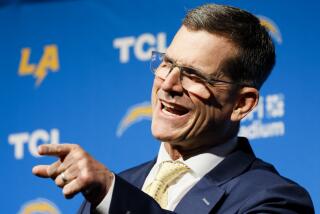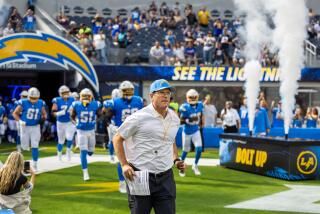Thumb Kind of Coach
MIAMI — He lost a kidney, ending his playing career, lost his first head coaching job in the NFL after only 20 games, lost the assignment to tutor John Elway early on, but today Mike Shanahan stands before you tops in the business.
The Broncos are a Bill Walsh/Vince Lombardi-like 47-17 under Shanahan, and one win away from claiming consecutive Super Bowl titles.
Dan Reeves, the man who gave Shanahan his first job in the NFL, might be the sentimental pick in Super Bowl XXXIII, but one look into the unforgiving, penetrating Shanahan visage suggests there will be no mercy.
Those who know Shanahan the best know how hard his feelings run toward Reeves, and they suspect he has intensified his game-plan preparations, which would make for a 25-hour day. And they fully expect him to not only win, but destroy Reeves, running up the score if the situation presents itself.
“With a lot of coaches, when you win they pat you on the back,” Elway says. “There’s not a whole lot of patting with Mike. He’s a classic grinder. Classic. He never lets up.”
Elway displays his thumb and then begins jamming it downward, restrained only by his imagination. “That thumb just pushes on you harder and harder when you win. When you lose, surprisingly enough, he pulls it back, but when you win, there’s no letup, no chance to get fat and sassy.”
Shanahan smiles that smile. He’s guilty as charged. No, he’s innocent. No, you will never really know by asking him. The smile, always the smile, masking what he must really think.
“I just know this,” says Shanahan, a quarterback at Eastern Illinois before losing a kidney in the spring game before his junior year. “Nothing lasts forever. Things can be going real good for you and then it can all be taken away. That’s my motivation to keep working hard--no letup.”
In your face, uncompromising, unchallenged as an offensive mastermind and unforgiving. Ten years ago he was in prison in Los Angeles, handcuffed as coach of the Raiders. After inheriting a 5-10 team, he improved to 7-9, but a 1-3 start compelled a meddling Al Davis to dismiss him.
Lesson No. 1 regarding Mike Shanahan: Do not do him wrong.
Does Shanahan harbor any ill will toward Davis?
“Most definitely, and he lets you know that,” says Denver running back Vaughn Hebron, and the message has also been relayed to Davis, 1-7 in his meetings with Shanahan’s Broncos.
Reeves hired Shanahan out of the University of Florida in 1984, rehired him as quarterbacks’ coach after his Raiders’ misadventure, and then asked him to leave after he felt he had become too close to Elway, thereby undermining his own relationship with the quarterback.
Lesson No. 2: You can get rid of him, but he won’t go away.
“I was absolutely delighted when Mike went to San Francisco after Dan fired him,” says Pat Bowlen, the Broncos’ owner. “He was almost hired by Pittsburgh, and I like the Pittsburgh organization, but at that point in time I was watching the 49ers because of the success they were having. I called [49er President) Carmen Policy and told him this guy’s dynamite--you need to hire him.”
Shanahan joined the 49ers in 1992. The following year Bowlen refused to renew Reeves’ contract and called Shanahan to coach the Broncos.
“And he wouldn’t come,” Bowlen says. “I couldn’t figure it out.”
Elway was even more stunned. “I threatened to kill him,” he says.
But Shanahan chose to stay with the 49ers two more years, the Broncos hiring and floundering with Wade Phillips.
The Broncos called again, and now the records are beginning to pile up. He has won 75% of his games as the Broncos’ coach--the best mark among active coaches--and in the 71 games he has coached in Denver, his team has scored 30 or more points 33 times.
Lesson No. 3: He’s only 46--just beginning to rule the football world.
“The only thing Mike learned in his experience in Los Angeles was how not to do things, so in hindsight the best thing for us and him was those two extra years in San Francisco,” Bowlen says. “He worked with the Bill Walsh blueprint and now he’s put his own spin on it.”
The 49ers had so much talent for the last two decades. The Broncos had Elway. Remarkably, Elway remains the only No. 1 draft pick starting on an offense that includes two players who were not drafted (tackle Tony Jones and wide receiver Rod Smith).
“Some of those guys think they should have been No. 1 picks,” said Elway, “and they are playing now to show that.”
Imagine assembling the best team in football, and having a pick of NFL talent. Would you start with Smith and Ed McCaffrey at wide receiver? Howard Griffith, the 237th pick in the 1991 draft, who wasn’t good enough for the Colts, Chargers, Rams and Panthers, starting at fullback?
Tight end Shannon Sharpe was a seventh-round choice. Guard Dan Neil, a third-rounder, represents the highest pick along the Denver offensive line, blocking for Terrell Davis, a sixth-round nugget. Tackle Harry Swayne began his career in Tampa as a defensive lineman.
“It’s all about people, Mike’s people,” Bowlen says. “You have to find players who buy into what you’re trying to do. These guys firmly believe he’s going to lead them to the Promised Land.”
That started day one with Elway when Reeves sought new ideas and enthusiasm for his team and hired Shanahan and Alex Gibbs from the college ranks. A youthful Shanahan had Elway’s endorsement and growing friendship, and in Gibbs, the team’s offensive line coach, Shanahan had the fiery technician to make his Xs and O’s so effective.
“This guy had the look of a head coach from the beginning,” Bowlen says. “Something I didn’t know about him was his approach to players. He’s blunt and they respect him for being so straightforward.”
His teams practice the same way with no nonsense, no break from routine, no pads.
“We have to play faster than the people playing against us,” he says, and that’s why the Broncos always look like they’re trying to catch the 5 p.m. bus home. “We don’t hit as much as other teams. We work on being more explosive, faster, quicker during the week.”
They have a corporate air about them as they prepare, and while trained well by their leader to render the “we take one game at a time” useless quote, given Sharpe’s mouth they aren’t exactly muzzled.
But here’s lesson No. 4--the Broncos stand in awe of their leader, if not in fear.
“One guy asked me, ‘What happens if you blow curfew?’ ” Sharpe says. “Well, you’d probably get fined $25,000 or $30,000. That’s not the problem. If Mike looks at you, that’s the real problem--because he looks at you in such a way you want to just drop your head. My mom or grandmother couldn’t look at me like that and make me feel any worse.”
Shanahan dominates the Broncos, controlling the hiring and firing of personnel. There’s already talk that if Denver loses the Super Bowl, defensive coordinator Greg Robinson will be fired.
Shanahan’s game, of course, is offense. The Broncos, beating the opposition by an average of 15 points, have started the last three years with no worse than a 9-1 start. They should be getting ready to play in a third consecutive Super Bowl if it were not for 14-point underdog Jacksonville, which stunned Denver two years ago in the first round of the playoffs.
“It still stings a lot,” Shanahan says, his eyes darting back and forth as if reviewing each devastating play. “It rips your guts out any time you miss an opportunity. You find out what went wrong, fix it, and don’t let it happen again.”
Reflect back on Shanahan Rules 1, 2 and 3. Since losing to Jacksonville two years ago, the Broncos have defeated the Jaguars twice by the combined score of 79-41.
“It’s a single-mindedness with him,” Bowlen says. “Mike Shanahan thinks about nothing else but football and the goal, the Super Bowl.”
And yet after winning the Super Bowl last year there was no way of knowing it listening to Shanahan. Miked by NFL Films for the game, officials said later he celebrated the greatest moment in Broncos’ history by walking silently from the field.
“I really felt going into the game we were going to win, so it wasn’t a surprise,” Shanahan says. “The thing is, I felt we had the chance to play even better than we did.”
The thumb pushing down, harder and harder.
“I know what it’s like to lose everything . . . “ he says, and he doesn’t need to finish the sentence: It won’t happen again.
More to Read
Go beyond the scoreboard
Get the latest on L.A.'s teams in the daily Sports Report newsletter.
You may occasionally receive promotional content from the Los Angeles Times.










